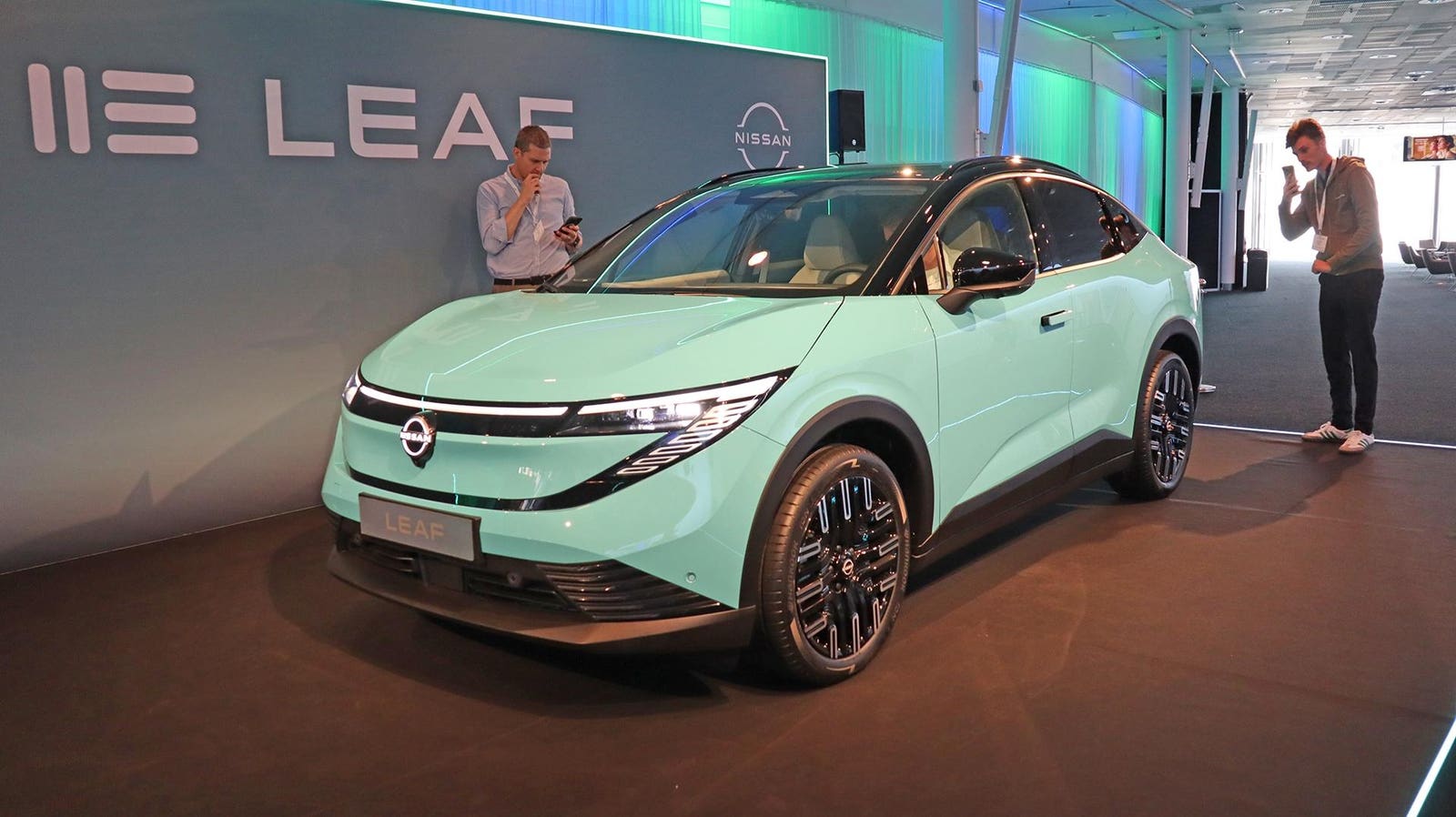The third generation Nissan Leaf was unveiled at EVS 38 in Gothenburg.
James Morris
Tesla might be the poster child of the electric vehicle revolution, but the Nissan Leaf deserves equal credit for making EVs viable as everyday cars. But Nissan hasn’t capitalized on its early lead with later electrified models, and has even been facing an economic crisis. Now the company has gone back to its electric roots with the third generation Nissan Leaf, which was unveiled at EVS 38 in Gothenburg in June. Is this a sign of a return to form? I talked to Nissan about how the new car could be part of a revival of fortunes for the company.
Nissan Leaf: Back To Mainstream EVs?
Nissan hasn’t been sitting on its laurels. The company has produced a credible larger EV in the shape of the Ariya, targeting the lucrative premium mid-sized SUV market that has been dominated by Tesla’s Model Y for a few years now. But despite the quality of this car, it hasn’t made a huge impact on the market yet, although the recent huge price drops could make it much more popular in the UK.
With the new, third generation Leaf, Nissan is hoping to hit a more everyday market than the Ariya. “The outgoing Leaf was well appreciated because of its size, performance and price,” says Shunsuke Shigemoto, Vice President of ePowertrain Technology, Research, and Advanced Engineering, Nissan. He also argues that the size is just right for European roads. “Cars are getting bigger, but the roads and parking spots aren’t.”
The new Leaf looks bigger than the previous one, but it’s almost exactly the same size.
James Morris
The new Leaf is about the same proportions as the previous model, although the design makes it look bigger. It’s slightly shorter in length and height, but a little wider. Shigemoto argues that the new Leaf’s practicality and technology are in a sweet spot. “It’s a compelling package that can go 600km, give or take.” The WLTP rating for the largest battery version (75kWh) is 604km (377 miles), which would imply high efficiency, although this hasn’t been officially certified yet.
“The first Leaf was very much made for early adopters, tech- or environment-oriented people that were blind to all the downsides of EVs at the time,” adds Xavier Tesson, product planning director, EMEA, India and Oceania, Electric Vehicles, Nissan. With the new Leaf, Nissan didn’t want the electric powertrain to be the focus anymore. “It should be an EV, but accessible to everybody, and not just tech for tech’s sake. We know that the Chinese are strong on tech, but it’s very often disconnected from its actual usage. I could put my grandma [in the new Nissan Leaf], and she would be fine.”
Building On The Nissan Leaf’s 15-Year History
Shigemoto argues that Nissan’s long experience from the previous Leafs has given it an advantage with the new one. “The 700,000 cars that we sold globally, but also the 290,000 that we sold in Europe, is a valuable asset in terms of technical knowledge and the engagement with our customers,” he says. “We could design the new Leaf around what we have learned. We are also expecting customers that previously owned the Leaf to move to the new one, but also people who are driving an e-power [Nissan’s serial hybrid technology]
or a Juke hybrid. We wanted to have the experience for our customers to be a continuum of a Nissan product.”
The new Nissan is styled to appeal to European buyers.
James Morris
“What we are focusing on today is the design,” says Tesson. “It’s very much adapted to Europe. In the past, it was slightly different story, a bit more Japanese.” Nissan’s use of assistance technology has been constrained by European regulations, but Tesson argues that the new Leaf will have as much new tech as possible. “We have not just intelligent cruise control, but intelligent regen as well, maximizing the benefits of the system linked to navigation. It now predicts when the curves are coming, when the hills are coming, and it does this automatically, without any user input.” Drivers can still adjust regeneration themselves, though, and decide whether to engage Nissan’s e-pedal single-pedal driving mode.
Can The Nissan Leaf Beat Chinese Competition?
However, the question remains whether Nissan can compete with the onslaught from Chinese EVs, particularly in the UK, which doesn’t currently tariff automotive imports at the level of the EU or USA. “Looking at the specifications, they are offering a compelling package at a price point,” says Shigemoto. “But we also know that they are producing in China and then shipping to Europe. It does look like the 80s between Japan and the US. BYD has announced that they’re going to put an industrial footprint in Europe, maybe other manufacturers will follow.” That will also change the prices the Chinese can offer, possibly erasing their cost advantage. “But we still must be at the top of our game to compete with them.”
“It’s not just the Chinese,” adds Tesson. “We’re going to have more Koreans, or even just historical European manufacturers.” In the UK, at least, the new Electric Car Grant that is awarded based on manufacturing carbon footprint could give Nissan an advantage. The Nissan Leaf will be produced in Sunderland, UK with many local components, making the supply chain extremely local. “We produce the car in the UK,” says Shigemoto. “Right across the road, we produce the battery, and we will also produce the three-in-one e-powertrain. We want to bring more suppliers to be in that industrial area in Sunderland. Our goal is carbon neutrality. It’s not just about the battery EV technology itself.”
However, Nissan isn’t putting all its eggs in the EV basket either when it comes to powertrains. “We have two pillars,” says Tesson. “The first pillar is EVs like the Leaf. This is the car that will help all those EV-resistant people move from ICE to electric. Now we have a great package that really fits the needs of most of our customers. That’s going to be our core model in the EV market, and it’s just one of them. We’re continuing Ariya. We announced Micra. Very soon, we are going to show [an electric] Juke. We are really coming strong with that EV offensive.”
Nissan has also recently announced an electrified version of its popular Micra small hatchback.
James Morris
“The second pillar is we’ve seen that electrification has slowed down quite a bit, but it’s still going strong,” adds Tesson. “So we have the second ICE pillar that we are strengthening as well. We’re continuing with a double powertrain offer. We have a great powertrain, e-power, that we have on Qashqai and X-Trail. We have a great more standard hybrid with Juke. We are about to showcase our new third generation e-power on Qashqai, bringing it to the next level. The Chinese are coming strong, but they still don’t know the European customers that well. We have that knowledge, and we’re capable of having a double offer that really caters to both populations in Europe.”
But the third generation Nissan Leaf is clearly a crucial product for the company’s European business, as EVs continue to grow in market share in most countries. Cars will be imported from the UK to Europe, but not the USA. It’s meant to hit a sweet spot of range, performance and technology for the European market, and even includes technical tricks like a “motion frosting” sunroof that can darken in sections – something previously only seen on premium cars like the Lotus Emeya. “We think the new Leaf is a compelling package,” says Shigemoto. “If we can meet the price, it’s going to be competitive. We’re back in the game!”









